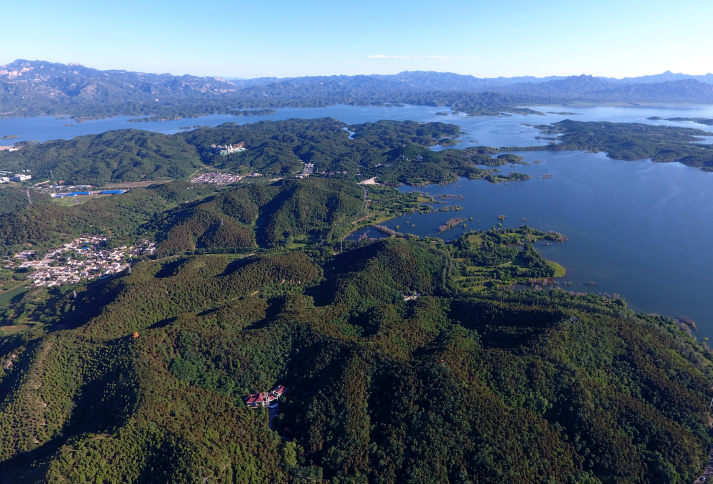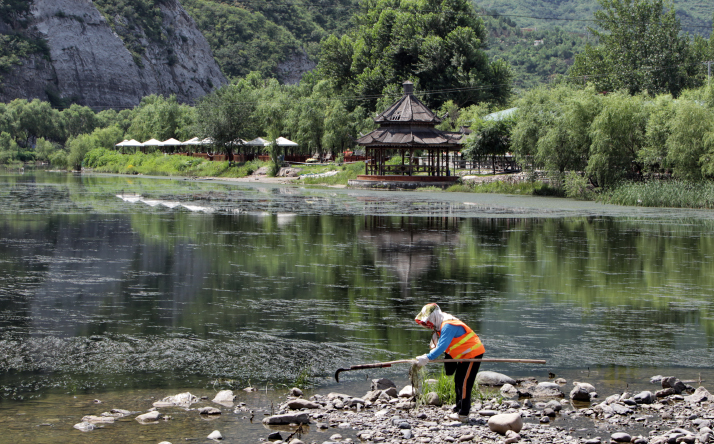|
||||||
|
||||||
| Home Nation World Business Opinion Lifestyle China Focus ChinAfrica Multimedia Columnists Documents Special Reports |
|
||||||
|
||||||
| Home Nation World Business Opinion Lifestyle China Focus ChinAfrica Multimedia Columnists Documents Special Reports |
| Nation |
| Water Development |
| Beijing's ecology improves with water systems restored |
| By Li Qing · 2019-05-06 · Source: NO. 19 MAY 9, 2019 |
 A view of the Miyun Reservoir in northeast Beijing on June 28, 2018 (XINHUA)
In 2008, Liu Jian, Vice Dean at the School of Architecture, Tsinghua University, led her students on a field research trip on urban planning to Liujiadian, a town in Pinggu District in northeast Beijing. The group also visited a river flowing through the area, the Ruhe River. They were told by a local that it had water only in the rainy season. "Last year, I visited there again and found that the river had dried up all year round," Liu said. Water shortage "Many cities developed around rivers. For Beijing, the Yongding River, the largest river in the municipality, is regarded as the mother river of the city," Liu Jian told Beijing Review. Historically, Beijing was a city with abundant water, with five major water bodies flowing through it—the Chaobai, Yongding, Daqing, Jiyun and Beiyun rivers. The water systems had a combined length of nearly 6,500 km. However, the permanent population of the capital now is around 21.5 million, and the average annual water resource in Beijing is 2.1 billion cubic meters according to official data. "So the per-capita water resource availability in Beijing is only about 100 cubic meters, making the city an area with water shortage at extreme level," said Liu Yanpeng, a senior engineer with China Academy of Urban Planning and Design. The continuous drought has made the condition worse, as the annual rainfall is about 480 mm, Liu Yanpeng said. Overpopulation in the capital and high-density buildings affect the management of water systems, said Zhou Feixiang, Deputy Director of the Ecological Environment Institution, China Academy of Urban Planning and Design. To address these problems, the Beijing Municipal Government has stepped up efforts for the protection of water bodies and treatment of polluted water. The efforts saw results last year. The water in the Miyun Reservoir, a major reservoir in Beijing, exceeded 2.5 billion cubic meters, the largest volume since 2000. The groundwater in the plain area of the city rose by 2 meters, and 4,000 hectares of wetland were restored or created. To control pollution, in 2018, Beijing built 800 km of sewage pipelines and 15 plants for reclaiming wastewater, resolving the sewage problems of 300 villages. At the same time, over 90 percent of 57 water bodies with black or malodorous water were cleaned up. "The blueprint for clean water and good scenery is being implemented, thanks to joint efforts," Zhou said. Incentive and cooperation To manage the major rivers and restore the ecological environment, specific methods have been worked out in accordance with the condition and unique features of these rivers. For instance, the water of the Yongding River has decreased by 10 percent since the 1970s because of the construction of water conservancy facilities such as dams. The development of the economy in the areas along the river also led to the use of more water, creating a water shortage and causing the surrounding ecosystem to degrade. In 2016, a comprehensive management program for the river's ecological restoration was launched with an investment of 37 billion yuan ($5.52 billion). The target was to ensure water supply through a rational allocation of local water sources and external diverted water, taking into consideration the different situations upstream and downstream, agricultural water conservation and containing groundwater extraction. The treatment of the Yongding River also involves developing its extended functions, such as utilization of the Guanting Reservoir on the river, a major water source for Beijing. For example, the reservoir could play an important role in water supply during big events or activities held in Beijing like the ongoing 2019 Horticultural Expo. Since the Yongding River flows through Beijing and Tianjin municipalities, Shanxi and Hebei provinces and Inner Mongolia Autonomous Region, regional cooperation is necessary for managing its waters. Although cooperation among these places started in the 1990s, it was not effective due to the lack of a common objective, coordinated measures and unified standards. In December 2018, Beijing, Tianjin, Hebei and Shanxi signed an agreement, clarifying their responsibilities in restoring the river ecology. The target is to restore the ecological system of the entire river by 2025. The mechanism of river chiefs has also contributed to the effectiveness of the water management. Local officials are responsible for water resource protection, pollution prevention and control, and ecological restoration of rivers. "It is a good solution for water treatment, motivating many administrations in a coordinated way," Liu Jian pointed out. To help the river chiefs pinpoint the problems, ecological protection departments at all levels in Beijing are conducting special inspections of selected river basins every month, monitoring the water quality. Based on the findings, solutions are proposed to improve the water quality. People and companies found violating the rules and polluting the waters are punished. A long-term mechanism for polluted water treatment has been established, which includes enhancing the capacity to treat industrial wastewater and domestic sewage and addressing shortcomings in sewage treatment facilities.  A worker picks up garbage from the Yongding River in west Beijing on July 14, 2017 (XINHUA)
City planning Despite the progress, there are still many difficulties in water governance. "It is a complex issue, concerning not just the quality of water but also water safety, water utilization and the living environment of the people," Liu Jian told Beijing Review. She said Zhejiang Province in east China has done this successfully, addressing water supply together with pollution control and water saving. Beijing can learn from the province in this respect. One challenge, according to Zhou, is that some urban areas in Beijing are not well planned. Development designs should include improving the water environment and water safety from the very start, he said. Then there are floods to contend with. "After the flood caused by heavy rain in 2012 in Beijing, people began to pay attention to the need for city flood control," Liu Jian said. However, the flood prevention facilities are solid enough but lack the beauty of landscaping. People are losing access to water bodies because of these constructions. To enable interaction between people and nature, it is better to use methods like greening or build steps to the water bodies so that people can access them and this will also add aesthetic value, Liu Jian said. "It should be the next task for the development of waterfronts," she said. She also said the water supply during big events held in Beijing can provide experiences for the management of water systems in the entire city. Temporarily augmenting the water of the Guishui River, adjacent to the venue of the horticultural expo, cannot be a long-term solution. Other methods, such as rainwater collecting, can be effective, especially in suburbs with low density population. "The key is to take advantage of local water resources," Liu Jian explained, highlighting the necessity of building a sponge city that is designed to recycle water. She also suggested that people learn from the advanced green technologies and innovative concepts that would be showcased at the Beijing horticultural expo that runs from April 29 to October 7. These will strengthen public awareness of environmental protection, reminding people to save and reuse water. Copyedited by Sudeshna Sarkar Comments to liqing@bjreview.com |
About Us | Contact Us | Advertise with Us | Subscribe
|
||
| Copyright Beijing Review All rights reserved 京ICP备08005356号 京公网安备110102005860号 |